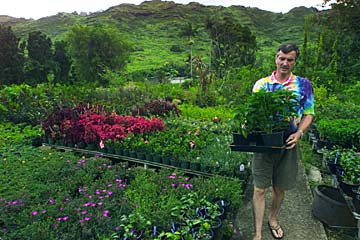
Kamilonui Valley, which has many nurseries and farms, faces the possibility of future residential development.
Farming urged
for KamilonuiThe City Council approves
a resolution to keep the valley
off limits to urban construction
East Honolulu's Kamilonui Valley should stay in agriculture -- at least for now, a City Council committee signaled yesterday.
The Council's Planning Committee approved a resolution that supports keeping urban development out of the farming valley, being eyed for housing construction.
But at least one councilman said that whether this valley remains in farming in the future could decide how well growth is managed on Oahu.
"To allow a change like in Hawaii Kai like we're presented here, would set a very bad precedent," Councilman Gary Okino said. "It's very important for the island's welfare that we be able to develop in a more sensible, or what they call 'smart,' growth manner."
All but three of the 13 farmers who lease land in the valley are considering preliminary offers made recently by Stanford Carr Development, which announced hopes earlier this year to build 200 homes in the valley's 83 acres.
More than a dozen Hawaii Kai residents testified that they'd like the area to remain in agriculture because it's one of the few remaining pieces of open and green areas in East Honolulu.
Natalie Iwasa, who has lived in Hawaii Kai for 15 years, takes her children bike riding through Kamilonui Valley.
"The reason is we call it our country because it's the only place where we can go where it is quiet and we can listen to the birds and we can smell the fresh smells. It's not the pavement. It's a beautiful place and we love it the way it is," said Iwasa, her children next to her.
"It's outrageous that we would try to take the last piece of agricultural zoned land in all of East Honolulu ... when we already have thousands of units worth of housing ready to go," resident Bob Hampton said.
Lillie Wong, president of the Kamilonui Farm Cooperative, asked the committee to defer taking action on the measure. "Because of the marginal land, the farmers cannot survive," Wong said.
Jim Stone, an attorney for the farmers, said the majority of the farmers want out because they're in their 70s and 80s, ill and ready to move on.
"Kamilonui Valley is clearly a valley in transition," Stone testified.
The East Honolulu Sustainable Communities Plan, which was approved in 1999 and which designates Kamilonui for agriculture, is currently under review by the city.
Okino, a planner by profession, warned that should Kamilonui fall out of farming, the process for determining where growth should be directed would be weakened. "I don't think we should take this too lightly."
But Councilman Romy Cachola suggested that it should be the farmers to determine their own future and not other residents. He said he voted in favor of the resolution but said that could change once the East Honolulu plan review is completed.
The resolution, which has no force or effect of law, is now scheduled for a Council vote on Aug. 11.
City Council
www.co.honolulu.hi.us/council/index1.htm
